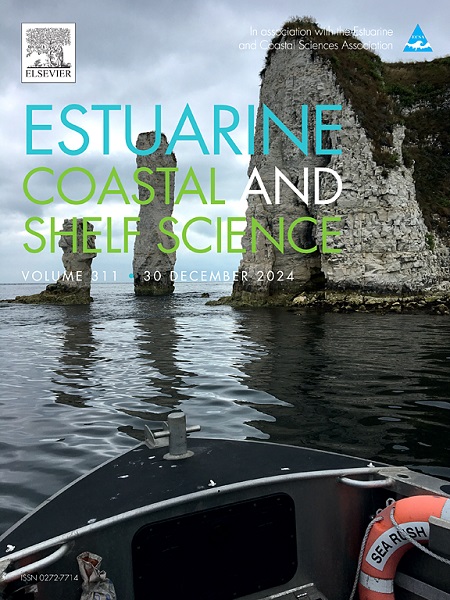Time series satellite remote sensing reveals annual distribution, composition, and trajectory of tidal wetlands in the Yellow River Delta
IF 2.6
3区 地球科学
Q1 MARINE & FRESHWATER BIOLOGY
引用次数: 0
Abstract
Tidal wetlands are vital ecological and economic bridges connecting terrestrial and marine ecosystems. Despite their importance, tidal wetlands face threats from human interference, biological invasion, unstable hydrology, and climate change, while remote sensing observations of them still face issues such as turbid water disturbance, limited datasets, and spectral similarity. As a result, detailed, long-term, and accurate annual mapping of tidal wetlands is often lacking globally, limiting the understanding and conservation of this important ecosystem. Taking the Yellow River Delta (YRD) as the studying site, we proposed an efficient and generalizable algorithm with Landsat images from 1985 to 2022 to systematically map the yearly tidal wetlands. The major components include tidal flats, dry flats, Suaeda salsa, Tamarix chinensis, Phragmites australis, artificial ponds and Spartina alterniflora. This algorithm effectively avoids interference from turbid water in tidal flat monitoring and spectral similarity in salt marsh monitoring while ensuring the reliability of image-based sample collection, achieving an average overall accuracy of over 92 %. The resultant 30-m spatial resolution map is the most comprehensive long-term observation of tidal wetlands to date, detailing their annual distribution and composition in the YRD. Furthermore, we investigated the evolution of the various components and subregions and found that the trajectory of tidal wetlands in the YRD exhibited six stages. This research aims to offer a robust solution for accurate tidal wetlands mapping and enhance our understanding of these ecosystems in turbid estuaries.
时间序列卫星遥感揭示了黄河三角洲潮汐湿地的年分布、组成和变化轨迹
潮汐湿地是连接陆地和海洋生态系统的重要生态和经济桥梁。潮汐湿地具有重要意义,但也面临着人类干扰、生物入侵、水文不稳定、气候变化等因素的威胁,遥感观测还面临着浑浊水体干扰、数据集有限、光谱相似性等问题。因此,全球往往缺乏详细、长期、准确的潮汐湿地年度地图,限制了对这一重要生态系统的认识和保护。以黄河三角洲(YRD)为研究点,利用1985 - 2022年的Landsat影像,提出了一种高效、可推广的年潮湿地系统制图算法。主要成分有潮滩、干滩、沙特阿拉伯、柽柳、芦苇、人工池塘和互花米草。该算法有效地避免了潮滩监测中浑浊水的干扰和盐沼监测中光谱相似度的干扰,保证了基于图像的样本采集的可靠性,总体平均精度达到92%以上。绘制的30米空间分辨率图是迄今为止最全面的潮汐湿地长期观测图,详细描述了它们在长三角的年分布和组成。在此基础上,研究了长三角潮湿地各组成部分和各分区的演变特征,发现长三角潮湿地的演变轨迹表现为6个阶段。本研究旨在为潮汐湿地的精确测绘提供一个强有力的解决方案,并提高我们对浑浊河口生态系统的认识。
本文章由计算机程序翻译,如有差异,请以英文原文为准。
求助全文
约1分钟内获得全文
求助全文
来源期刊
CiteScore
5.60
自引率
7.10%
发文量
374
审稿时长
9 months
期刊介绍:
Estuarine, Coastal and Shelf Science is an international multidisciplinary journal devoted to the analysis of saline water phenomena ranging from the outer edge of the continental shelf to the upper limits of the tidal zone. The journal provides a unique forum, unifying the multidisciplinary approaches to the study of the oceanography of estuaries, coastal zones, and continental shelf seas. It features original research papers, review papers and short communications treating such disciplines as zoology, botany, geology, sedimentology, physical oceanography.

 求助内容:
求助内容: 应助结果提醒方式:
应助结果提醒方式:


